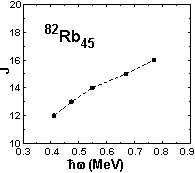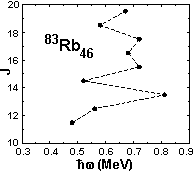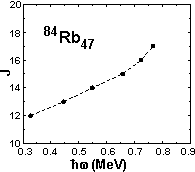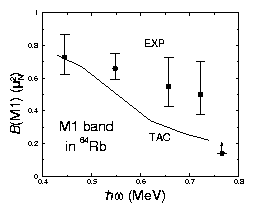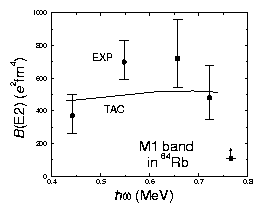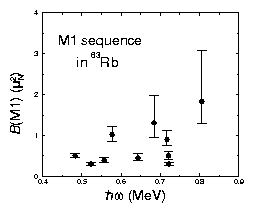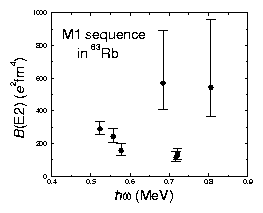|
R. Schwengner, G. Rainovski1, H. Schnare, A. Wagner,
F. Dönau, M. Hausmann2, O. Iordanov2, A. Jungclaus2,
K.P. Lieb2, D.R. Napoli3, G. de Angelis3, M. Axiotis3,
F. Brandolini4, N. Marginean3, C. Rossi Alvarez4
|
|
Searching for magnetic rotation in the mass region around A = 80 we
studied the isotopes 82Rb45, 83Rb46 and 84Rb47.
We found magnetic dipole (M1) sequences with varying properties in each
nucleus. The M1 bands in the odd-odd nuclei 82Rb and 84Rb
follow the regular rotational behaviour
(E ~ J(J + 1), i.e. J ~ (h/2p) w) which can be seen
in Fig. 1. B(M1)/B(E2) ratios determined from branching ratios of
transitions within the M1 bands reach values up to
25 (mN/eb)2 and decrease smoothly with increasing spin in a
range of 13 £ J £ 16. This behaviour is typical for magnetic rotation
and caused by the gradual alignment of the spins of the involved proton and
neutron orbitals (shears mechanism). The regular negative-parity M1 bands in
82Rb and 84Rb are well described within the tilted-axis cranking
(TAC) model [1] on the basis of the lowest-lying four-quasiparticle (4-qp)
configuration: p(fp) p(g9/22) n(g9/2) [2].
Fig. 1
Spin as a function of rotational frequency in the M1 bands of 82Rb
(left panel), 83Rb (middle panel) and 84Rb (right panel). Lines are
drawn to guide the eye.
So far, the interpretation of the M1 bands was based on B(M1)/B(E2) ratios
deduced from g-ray intensities. However, a detailed test of the
predictions of the tilted-axis cranking model requires the knowledge of
absolute M1 and E2 transition strengths. Therefore, we carried out a
measurement of level lifetimes using the reaction 11B + 76Ge
(E = 45 MeV) at the XTU tandem accelerator of the LNL Legnaro. Gamma rays
were detected with the spectrometer GASP. A thick target was used to stop the
recoil nuclei. Level lifetimes were deduced from a lineshape analysis applying
the Doppler-shift-attenuation method.
Absolute experimental transition strengths within the M1 band of 84Rb
derived from the present lifetime measurement are compared with predictions of
TAC calculations [2] in Fig. 2. The experimental B(M1) values show a smooth
decrease with increasing rotational frequency which may indicate the shears
mechanism, but is not as pronounced as the calculated behaviour. The
experimental B(E2) values increase up to (h/2p)w » 0.6 MeV and
decrease strongly towards higher frequency which may indicate a loss of
collectivity due to a change of the structure. However, the calculated
B(E2) values stay almost constant over the considered frequency range.
In contrast to the odd-odd isotopes, the negative-parity M1 sequence in the
odd-even nucleus 83Rb is not regular, which can be seen in Fig. 1.
Moreover, the B(M1)/B(E2) ratios reveal a pronounced staggering that is not
compatible with the shears mechanism [3] and cannot be described in the TAC
model. Based on the present lifetime measurement we deduced absolute
transition strengths within the negative-parity M1 sequence of 83Rb
which are shown in Fig. 3.
Fig. 2
Experimental and calculated B(M1) (left panel) and B(E2) (right panel)
transition strengths versus the rotational frequency in the M1 band of
84Rb.
Fig. 3
Experimental and calculated B(M1) (left panel) and B(E2) (right panel)
transition strengths versus the rotational frequency in the negative-parity
M1 sequence of 83Rb.
The experimental B(M1) as well as the B(E2) values show an irregular
behaviour which is considered as the consequence of the even neutron number of
this isotope in difference to the two odd-odd neighbours 82Rb45 and
84Rb47. In 83Rb, the breakup of a neutron pair is necessary to
generate excitations that include unpaired nucleons of both kinds. A possible
configuration of negative parity is the 3-qp configuration
p(g9/2) n(g9/2) n(fp). This configuration has one g9/2
particle less than the 4-qp configuration assumed for the odd-odd isotopes
and, therefore, less possibilities to generate high spins.
This and the specific neutron orbitals obviously lead to a spin coupling
which cannot realize the shears mechanism. A further possible configuration
similar to the one in the odd-odd isotopes is the 4-qp configuration
p(fp) p(g9/22) n(g9/22) which may occur at higher energy.
The different behaviour of the isotopes with odd numbers of N = 45, 47 on
the one hand and an even number of N = 46 on the other hand demonstrates the
delicate balance between irregular and coherent collective motion in this
mass region.
1 FZR and Faculty of Physics, University of Sofia, 1164 Sofia,
Bulgaria
2 II. Physikalisches Institut, Universität Göttingen,
37073 Göttingen
3 INFN, Laboratori Nazionali di Legnaro, 35020 Legnaro, Italy
4 INFN and Dipartimento di Fisica dell'Universita di Padova,
35131 Padova, Italy
References
[1] S. Frauendorf, Nucl. Phys. A 557, 259c (1993)
[2] H. Schnare et al., Phys. Rev. Lett. 82, 4408 (1999)
[3] R. Schwengner et al., J. of Res. of NIST 105, 133 (2000)
IKH
06/21/01
© rs
|
